CAMBYSES II, Heir to Cyrus the Great (530 - 522 BC) Part 1
Cyrus the Great died in 530 BC whilst fighting in the north-east against the Massagetae. His successor was his eldest son Cambyses, now Cambyses II. He carried out his father’s pre-made plans to conquer Egypt. He had a fleet organise a navy, drawing up from the more seafaring peoples of his empire (namely: the Phoenicians and Greeks), to sail on the Nile Delta in Lower (northern) Egypt. He then had the veteran army of Cyrus mustered to march on Gaza and cross the desert beyond. A hard battle was fought at the frontier post of Pelusium, a battle in which Greeks fought on both sides. Egypt was finally brought into the Persian Empire by 525 BC. The last few months of Cambyses' reign would see the Shah be driven to insanity, and thus to his eventual downfall; On his journey home the same year, and while in Syria, Cambyses died.
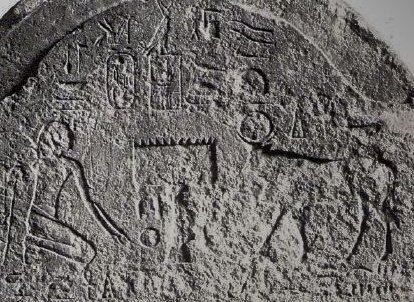
[ABOVE: Cambyses (left) worshipping the Apis Bull, 524 BC]
Within one generation, the Middle East’s political geography had been completely transformed, and the Greeks had almost become like trouble-makers along the frontier of the worlds number one superpower.
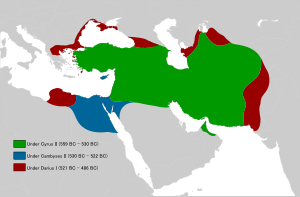
[ABOVE: Expansion of the Persian Empire under Cambyses (blue)]
ASCENSION TO THE THRONE
Cyrus’s wife Cassandane, daughter of Pharnaspes, had died during Cyrus’s lifetime, and Cyrus had ordered all of his subjects to grieve on her behalf during his reign. Once Cambyses took to his father’s throne, he saw Ionians and Aeolians as slaves that he had inherited for himself; his campaigns in Egypt would see him heavily utilise Greek mercenaries at his will.
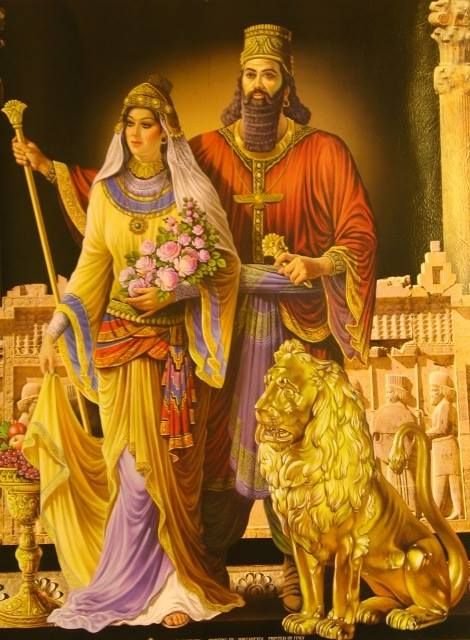
[ABOVE: Cyrus II and his wife Cassandane, mother of Cambyses II]
MOTIVES AGAINST EGYPT
Amasis II was pharaoh of Egypt from 570 until 526 BC, and was the king that Cambyses now had a grudge on. The reason Cambyses felt the need to march an army onto Egypt, recruited from all ethnic corners of his empire, came about after Cambyses had asked Amasis for his daughter’s hand in marriage, and it was an Egyptian doctor who made this request to Cambyses in the first place. This doctor was chosen by Amasis himself to leave behind his wife and children, go to Persia and see to Cyrus’s eye during his reign. Due to this mistreatment, it was this doctor that persuaded Cambyses to ask for Amasis’s daughter, knowing he’d either accept, or refuse and anger the Persian king.
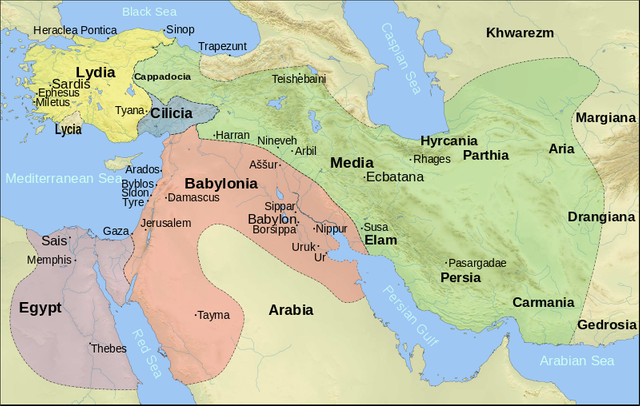
[ABOVE: The Egyptian Empire (purple) under the 26th Dynasty, 6th century BC, before the rise of Persia]
Knowing he may just make his daughter a concubine instead, Amasis, fearing of the now near-unchallenged might of the Achaemenid Empire, weighed up his options, and instead of sending his own daughter to Cambyses, he sent the daughter of the previous pharaoh, Apries, called Nitetis. She’s described in ancient sources to have been very tall and beautiful, and the only member of the Apries lineage left alive at the time. Amasis sent Nitetis off to Persia dressed in jewellery and the finest clothing available as if she were his own daughter. Upon arriving in the presence of Cambyses though, she simply told him the truth. Angered, he now had his own motive to move on Egypt.
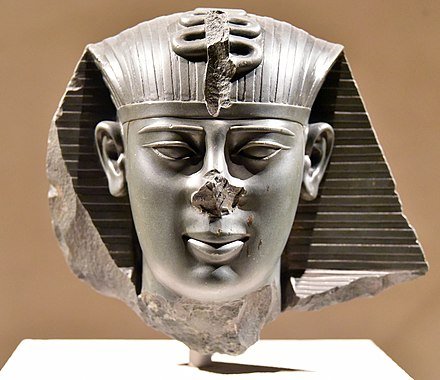
[ABOVE: Bust of Amasis II, c.550 BC]
EGYPTIAN CAMPAIGN
A Greek mercenary from Halicarnassus on the side of Amasis was a man named Phanes, who was known to be resourceful and brave on the battlefield. For an unknown reason, Phanes was disgruntled with Amasis, leaving him and taking a ship to Cambyses’ side. Since Phanes had some standing while in Egypt and had much knowledge on Egyptian customs and affairs, Amasis made the capture of Phanes a priority. Sending his most trusted of eunuchs to find him via trireme, and while he did capture Phanes while in Lycia, he failed in bringing the mercenary back to Egypt after being outsmarted by him by getting his guards drunk and escaping to Persia in the night. Upon arriving in Persia, he found Cambyses in a state of intending to invade Egypt, but unsure which route to take to get to Egypt through the desert. Meeting up with him, Phanes told Cambyses about how things were politically in Egypt, and gave him the best route to take to Egypt.
The desert was the clearest way into Africa. Lands from Phoenicia to the borders of the city of Cadytis were owned by the Palestinian Syrians. Trading centres on the coast from Cadytis down to the Egyptian border near Lake Serbonis belonged to the Arabians and Syrians. Yearly imports of clay jars full of wine into Egypt coming from Phoenicia and Greece, while they did end up in Egypt, could not be found anywhere when Cambyses reached Egypt. Every headman in Egypt had to carry every jar belonging to their community over to Memphis to fill them with water and take them to the waterless areas of Syria. It was the Persians who opened up the way into Egypt this way, via the supplying of water to Cambyses’ route into Egypt using this method straight after the conquest of Egypt was over. But during the conquest, there was no water along the route to supply his army. Finding this out, Cambyses sent envoys to Arabia, asked for safe passage through their lands, and pledges were received and given between them. The Arab king, himself being an enemy of Amasis, filled camel skins with water, loaded them all onto his living camels, and left them in the desert awaiting Cambyses’ forces.
THE BATTLE OF PELUSIUM, 525 BC
Succeeding Amasis II, Psammenitus stationed his forces by the Nile’s Pelusian mouth, awaiting Cambyses, who invaded Egypt finding Amasis was no longer living. Just as Cambyses arrived with his soldiers in Egypt, the Egyptian city of Thebes saw rain for the very first time in Egyptian history. This was likely taken as a sign of things to come. With the Persians across the desert, Cambyses moved his forces opposite his Egyptian foe to join in battle. It was then that Egypt’s mercenary forces, made primarily of Greeks and Carians and angry at Phanes who showed a foreign army a way to enter Egyptian territory, brought Phanes’ sons, who were left behind in Egypt, to the Egyptian army’s camp. Their throats were cut and their blood dripped into bowls they had placed below them, adding water and wine to the bowl and drinking the mixture before joining battle, today known as the Battle of Pelusium, occurring in May 525 BC. While the fighting was fierce on both sides and casualties were plenty, the Egyptian army was eventually routed from the field, fleeing to Memphis. According to Ctesias, a Greek historian living under Persian rule years later, 7,000 troops were lost on the Persian side, while 50,000 were lost under the Egyptian side.
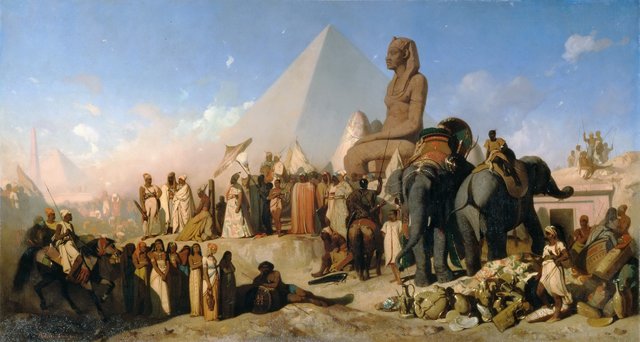
[ABOVE: "Cambyses Meets Psamtik III", imaginary painting by French oriental painter, Jean-Adrien Guignet (1816 – 1854)]
SIEGE OF MEMPHIS
While the Egyptian forces hid in Memphis, Cambyses sent a Persian herald up the Nile on a Mytilenean boat to ask for a truce. However the ship was destroyed completely by the Egyptians as soon as they saw it, carrying the remains of the ship - and people - that they tore up. Upon receiving this ‘reply’, Cambyses had the city besieged, and the city was soon taken. Libyans to the west, hearing of what had so quickly happened to their once-powerful neighbours, surrendered immediately to Cambyses, and began offering tributes to the Persians. Soon after, the Greek cities of Cyrene and Barca in Libya also followed suit and surrendered without a fight to Persia. While pleased with the Libyan offerings, Cambyses wasn’t pleased with the Cyreneans’ offerings, which was 500 minas (nearly a quarter of a tonne) of silver, which Cambyses offered immediately to his army.
PSAMMENITUS, THE LAST EGYPTIANS PHARAOH OF EGYPT (526 - 525 BC)
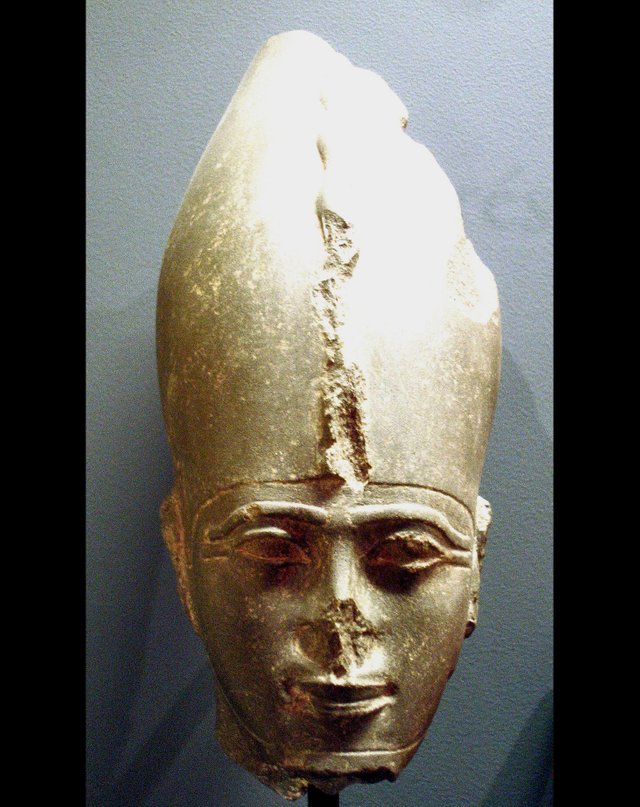
[ABOVE: Bust of Psammenitus III, last Egyptian Pharaoh of Egypt]
Psammenitus’s reign as the last Egyptian Pharaoh of Egypt’s 26th Dynasty lasted only 6 months. 9 days following his capture of Memphis, Cambyses sent a group of Egyptian captives, including Psammenitus, sit at the borders of Memphis, tormenting him from the walls of the city with his own army to test the Pharaoh’s courage. Cambyses also had women once chosen by Psammenitus to be the leading women of Egyptian nobles, including his own daughter. Passing their teary-eyed fathers, their daughters too were crying whilst being humiliated. But when Psammenitus saw the girls and saw what was happening, he merely bowed his head down. Cambyses then sent out 2,000 Egyptian men, alongside Psammenitus’ son, with ropes around their necks and trash in their mouths. They were being walked in chains to pay for the killing of the Mytilineans who were killed by them in their ships outside of Memphis; the royal Persian judges had declared that for every Mytilinean that had been killed, 10 Egyptians were to be killed. Realising his son was off to be killed with the other 2,000 men, he remained silent unlike the other wailing Egyptians around him. Nearby to him, a man who had been reduced to poverty and begging by the Persian invasion approached the foreign army and begged them. Seeing him, Psammenitus struck the man on the head. The army relayed a message to Cambyses, who in turn asked Psammenitus why the sight of his son and daughter did not bring him to an emotional reaction, but an unrelated beggar did. Psammenitus responded:
"Son of Cyrus, my personal troubles are too immense to cry over, but when a friend on the threshold of old age has lost a fortune and happiness, and been reduced to beggary, his sorrow calls for tears."
[Herodotus, 3.14]
Thinking he had spoken well, Cambyses received this response well. It even brought Croesus, who had come to Egypt alongside Cambyses, to tears. Feeling pity for the pharaoh, Cambyses had his son removed from chains, and Psammenitus himself was brought to the Persian Shah’s presence. The soldiers sent to fetch Psammenitus’ son were too late however; the Pharaoh’s son had been the first Egyptian of the captives to be killed, so Psammenitus instead was brought to Cambyses. From there, the former Pharaoh lived an easy life, to such an extent that if he would have been able to remain clear of any politics, he might have regained Egypt and just ruled under Cambyses as his regent, as Persians tended to honour the sons of kings; they even gave the sons of a king who might have rebelled against them their whole nation back, like in the cases of Thannyras, son of Inaros, who reclaimed his father’s kingdom. In this case though, as it happened, Psammenitus set out to conspire against Cambyses and the Persians, and reap the reward in turn. When he was caught inciting his people towards rebellion, and when Cambyses caught word of this, Psammenitus drank bulls blood and died there and then, killing the last native Egyptian pharaoh.
Cambyses, however, wanted to travel to Saïs, north of Memphis in the Nile Delta. This was the previous residence of Amasis. Once at Amasis’ home, Cambyses ordered for the Pharaoh’s corpse to be removed from its coffin, where it was to be brought outside, further ordering his men to flog the corpse, pull out its hair and poke it with goads. However, as Amasis’ body had been mummified, the body resisted their efforts and was never disintegrated by the Persians, so as the soldiers tired from attempting to disfigure the corpse, Cambyses ordered it burnt instead, a sacrilegious order since fire was considered by the Persians to be a god, to the point where cremation was not allowed as a practice in Persia, because it was considered by Persians as such to present a corpse to a deity. It happened though that the body was not Amasis’s, but another mans of a similar build. Amasis, knowing what might happen to his body after his death, ordered his son to bury him in a recess of the tomb, and ordered the other man who ended up being flogged in his place to be buried in his tomb instead. This story may have been invented by the Egyptians however, told to make an impression, but we don’t know for sure.
PLANNED ATTACKS ON CARTHAGE, AMMONIA AND ETHIOPIA
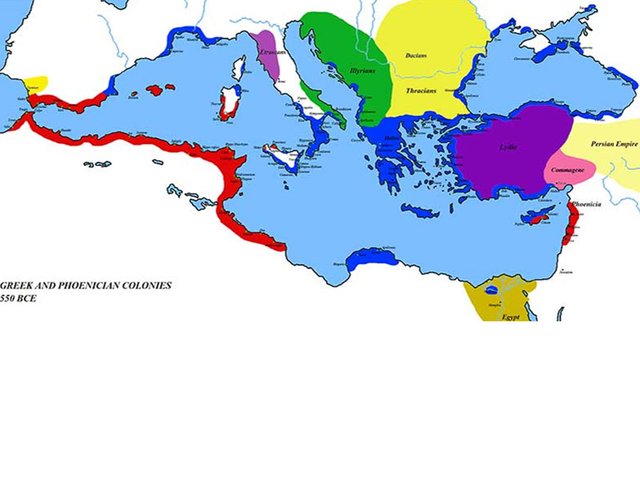
[ABOVE: 6th century empire of Carthage (red)]
Cambyses soon after set his sights on more military campaigns: against the Carthaginians by sea, the Ammonians by land, and the Ethiopians via espionage first. Cambyses wanted to send in spies to Ethiopia to give the local king gifts ostensibly while meddling with state affairs. While gathering men from Elephantine in Egypt who spoke and understood Ethiopian, he ordered the Persian navy, native Phoenicians, to begin attacking Carthage, but since Carthage itself was a Phoenician colony, they refused. The remainder of the Persian navy therefore was not adequate enough to take on the Carthaginians. Cambyses gave these spies gifts of arm bands, a golden torque, wine and perfume to hand to the Ethiopian king. Not knowing exactly who the king of Ethiopia was, the plan was to hand these gifts to the tallest and strongest looking men in Ethiopia, since they thought that that was how an Ethiopian ascended to kingship. Eventually, the spies reached Ethiopia and handed gifts to the supposed king, stating:
"It is because Cambyses, king of Persia, wants to be your guest-friend and your ally that he has sent us with instructions to hold talks with you., and that is why he is also giving you these gifts, which he particularly enjoys using.”
[Herodotus, 3.21]
However, the Ethiopian king realised that the men were indeed spies, replying to them:
"The Persian king has not sent you with gifts because he really wants my friendship. You’re lying: the real reason you are here is to spy on my kingdom. Your master’s behaviour is reprehensible too. If he were a good man, he would not have wanted to possess any land other than his own, and he wouldn’t have enslaved people who have done him no wrong. That is how things are, so I want you to give him this bow and say to him: “Here is a word of advice from the king of the Ethiopians. When the Persians can draw bows of this size as easily as I do now, then he can march against the long-lived Ethiopians - with an army that considerably outnumbers ours. In the meantime, he should be grateful to the gods for not making the sons of Ethiopia think of acquiring additional lands besides their own.””
[Herodotus, 3.21]
The Ethiopian king went on to claim the purple-dyed cloak and the perfume were not made how the Persians described it, he likened the golden bracelets to shackles, yet was pleasantly surprised by the wine. Once the Ethiopian learnt that Persian Shahs typically ate bread, grew wheat and lived long lives (up to 80 years) however, the king mocked further, claiming he was surprised men could live so long off of just manure, even with the good wine to potentially heal them, telling the Persians that Ethiopians typically endured life up to 120 years of age. The Persians were then shown an Ethiopian prison, seeing the men inside shackled in golden chains, and supposedly witnessing the Table of the Sun, a table that supposedly produced and presented its own food for everyone to eat.
When the Persians returned to Cambyses in Egypt, he was so furious at the Ethiopian response that he set about attacking before considering his armies’ logistics, or the fact that he was heading to the edge of the then-known world, leaving some Greek troops behind in Egypt. As a portion of his army reached Thebes and the Ammonian people, Cambyses ordered the population enslaved, and had the oracle of Zeus burnt down while taking the rest of his forces to Ethiopia. This army, however, ran out of food around one-quarter of the way there, and when the men had resorted to eating the pack animals, Cambyses still pressed onwards, ordering his soldiers to eat grass if needed. However, once the army reached the desert, the situation became so bad that each man had to draw lots, and 1 in 10 men was eaten by the others. Hearing of this and fearing the uprise of cannibalism, Cambyses finally ordered a withdrawal from Ethiopia, returning to Memphis and allowing the Greek garrison there to sail back to their homes.
It will be in Part 2 of the Cambyses' blog that we will look at Cambyses' descent into insanity, the reign of his successors and the rise of Darius the Great.
Stay tuned.
--
SOURCES
• Herodotus's "The Histories"
• Oswyn Murray's "Early Greece"
• Nic Field's "Thermopylae 480 BC"
All images used are license-free.
--
YOUTUBE LINK (I do not own this video)
Yore History's "CAMBYSES II - PERSIA RISES PART 2 - ACHAEMENID PERSIAN EMPIRE":
This is the fourth part in many blogs on the Achaemenid Empire. Go and check out the rest if you haven't already:
THE ACHAEMENID PERSIAN EMPIRE
https://steemit.com/hive-133974/@oo7harv/the-persian-empire-history-s-first-superpower
CYRUS THE GREAT, PART 1
https://steemit.com/hive-133974/@oo7harv/cyrus-the-great-conquests-of-media-and-lydia
CYRUS THE GREAT, PART 2
https://steemit.com/hive-133974/@oo7harv/cyrus-the-great-2-conquest-of-babylon-and-his-downfall
PERSIAN PROVERBS
https://steemit.com/quotes/@oo7harv/persian-proverbs
Don't forget to rate this post if you enjoyed reading it, and stay tuned to my History Community for more posts:
https://steemit.com/trending/hive-133974
Thanks for reading :)
Nicely articulated. I like ancient history, to know the history is to know the truth of your origin.
Thanks very much man :) Part 2 coming ASAP
Always been my favourite academic subject since I was a kid.
"Those who cannot remember the past are condemned to repeat it."